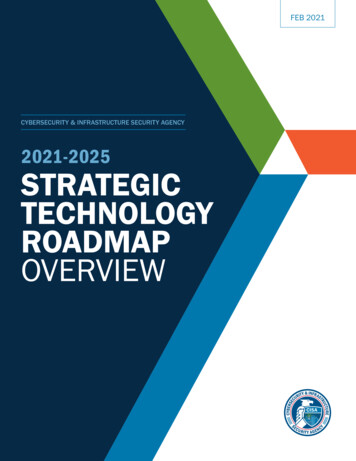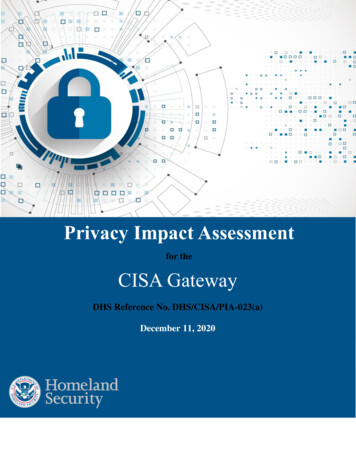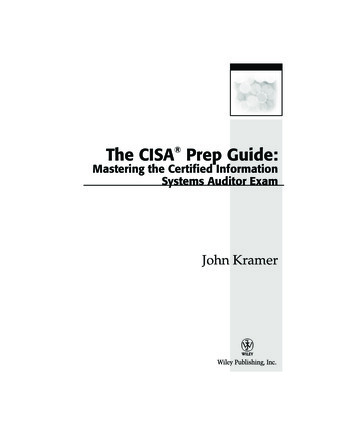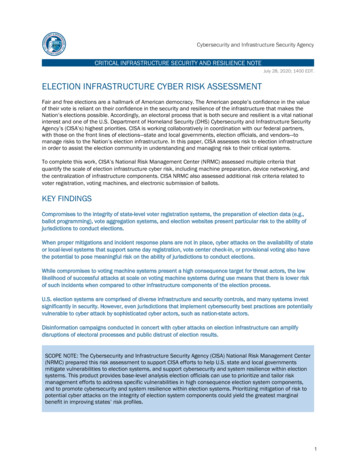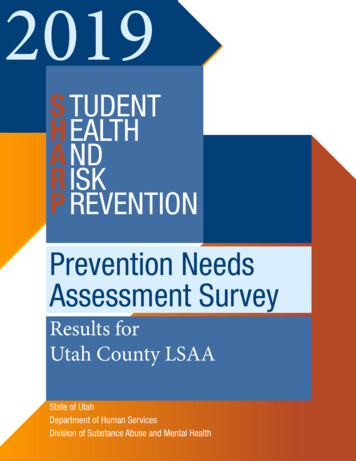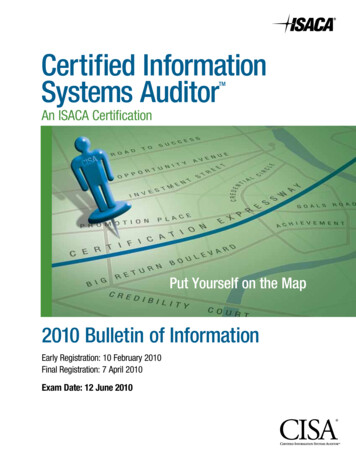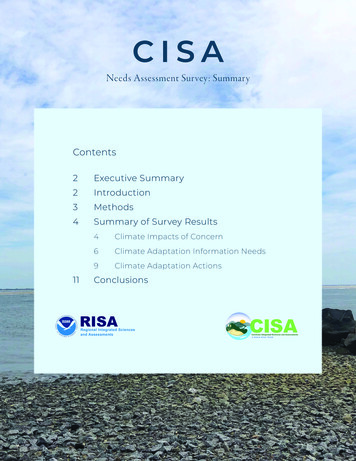
Transcription
CISANeeds Assessment Survey: Summar yContents2Executive Summary2Introduction3Methods4Summary of Survey Results114Climate Impacts of Concern6Climate Adaptation Information Needs9Climate Adaptation ActionsConclusions
Executive SummaryThe Carolinas Integrated Sciences & Assessments (CISA) surveyed the climate needs of various communitiesin North Carolina and South Carolina, receiving 313 responses over a one month period. The respondentscame from across the Carolinas and represent diverse stakeholders operating at different geographic scales andrepresenting different sectors. The planning, government, and NGO communities were well represented andthe survey reached many respondents who had not engaged with CISA before.The survey respondents indicated a need for climate information to integrate into planning and resilienceactions underway through their organizations. While not required to do so, respondents actively seek toincorporate climate information and needs into their work, and express moderate confidence in their abilityto find this information. This climate information is then used in a variety of ways. This summary reports ourfindings across three main sections.ImpactsInformationActionIn this section, we summarize which climate impacts are of most concern for ouroverall sample and for key subgroups. All respondents report high concern withextreme events, particularly heavy precipitation, and singular events. Concern overother impacts showed some variation based on sector and scale of work.In this section, we summarize which types of climate information are most useful orneeded by respondents. A key highlight is that respondents are seeking action-orientedinformation that enables them to move beyond simply understanding potentialclimate impacts.In this section, we summarize how respondents are incorporating climate informationinto their planning and resilience work. A synthesis of respondents’ answers showsa growing incorporation of climate into routine planning, with a wide variety ofplanning types mentioned. Organizations are also looking to incorporate climaterisk and resilience thinking across the board, especially in new short- or long-termplans that are being created now. Actions vary by subgroups, but commonalitiesinclude a need for funding opportunities, examples of success stories, and networkingopportunities to learn from others (especially when information is distilled andsummarized).2
IntroductionThe goal of this survey was to learn about the needs for assistance with climate sensitive decisions acrosscommunities in the Carolinas. Climate can influence and impact decision making in a variety of sectors,including public health, coastal management, water resources management, land use and environmentalmanagement, and hazard/extreme event planning. This survey thus serves to inform CISA and other groupsworking around climate-sensitive decisions in the Carolinas.MethodsThe survey received a total of 313 responses. The vast majority of respondents answered most of themain questions in the survey, with relatively few incomplete responses. Approximately half of surveyrespondents answered “grouping questions” (the level of geography they work in, sector, etc.). Thisreport provides key highlights from these subgroups alongside the summary data, but readers should beaware that the number of responses for these subgroups is usually much smaller (see Table 1). Counts arereported in figure captions when feasible.The survey was distributed using the snowball method in which we started with our contacts and askedthat others share with anyone they thought might be interested in participating. CISA sent out thesurvey to its contacts (e.g. a newsletter list with 3000 subscribers, social media with 500 followers)and encouraged the distribution of the survey via other platforms and organizations. For example, theAmerican Planning Association helped us reach out to planning communities in North and SouthCarolina and Soil & Water Conservation Districts distributed it to their email lists. Because of the diffusedissemination method, the survey likely sampled some communities more than others and information isnot available to calculate a response rate. The survey was active during the month of June, 2020.Figure 1: Survey respondent breakdown. Left: Approximate location information was available for about 50% ofrespondents and does not include those who submitted from outside of the Carolinas. Right: Subgroups of respondents whoprovided both sector and scale of their work. Note there are a few respondents who provided the sector but not the scale.3
Summary of Survey ResultsClimate Impacts of ConcernThe opening question in this survey asked respondents how concerned they are about impacts of differentprojected climate changes on their organization’s work including, for example, their mission, infrastructure oroperations. The overall results (see Figure 2) show extreme rainfall received the most responses of “extremelyconcerned” and “very concerned”, perhaps due to notable floods and the “rain bombs” that impacted theCarolinas in the past 5 years. Other climate-related hazards such as heat waves received high concern. Longerterm trends in climate variables often received a mix of high and moderate levels of concern.Figure 2: How all respondents ranked their levels of concern for certain climate impacts.We further analyzed these responses by breaking down subgroups into the level of geography in which theywork and by sector. There is overlap between the two subgroups; for example about 60% of planners saidthey worked at a local scale and 40% at a regional / state scale. Respondents working locally (see Figure 3)noted extremes (rainfall, heatwaves, and sea level rise (SLR) / tidal flooding) as important concerns, whilerespondents working at regional / state scales reported a wide variety of concerns. Local respondents alsotended to note more “Other impacts’’. Local NGOs and others raised concerns that climate impacts are ofspecial concern for low income and minority communities. Regional / state scale respondents noted extremes(e.g. droughts, floods, fire) or seasonal timings (e.g. late freezes).4
Many sectors have broad concerns (see Figure 4). Planners and other government officials ranked extreme rainfalland heat waves with notably high concern. The differences in sea level rise and tidal flooding at local scales may bedue to the number of respondents who do not work in the coastal zone. Respondents who are “not at all” concernedabout sea level rise and tidal flooding have similar answers to other climate impacts. NGOs listed a variety of “otherimpacts”, such as impacts to specific communities and impacts on socio-ecological systems (e.g. harmful algal bloomsor reductions in the environmental quality of life). “Other impacts” among all other sectors was more narrowly focusedon consequences of climate extremes (drought, fire, hurricanes) or threats to infrastructure.Figure 3: A breakdown of Figure 2 for respondents operating on the local scale (top) and regional / state scale(bottom). Note that the marked increase in “not at all concerned” for SLR and Tidal Flooding at local scalesmay be attributed to respondents who are far away from the coastal zone.5
Figure 4: For respondents who provided information on the sector in which they are employed, this graph showsthe number who ranked the impact as either “extremely concerned” or “very concerned”. Only sectors with 10respondents are shown (N 46, 30, 24, 18, 15, 12; respectively).Climate Adaptation Information NeedsA second group of questions gauged the climate adaptation information needs of the survey respondents.The first asked about assisting climate resilience work with different kinds of information (see Figure5). Participants were asked to select all that apply. The summary findings suggest that action-orientedinformation like model plans / ordinances and vulnerability assessments would be useful information forabout 60% of respondents, closely followed by adaptation strategies and case studies. Additional informationon climate impacts, projections and trends is viewed as somewhat likely ( 40-50%) to help support resiliencework (also note the increase in “possibly” and fewer “yes” responses). While few indicate any particularinformation as unhelpful, the findings indicate that, in addition to information on climate changes andprojections, more communities are seeking information to assist in developing responses.A breakdown by subgroups (see Figure 6) supports this general view, noting that larger geographic scales aswell as planners and consultants have a stronger relative preference for impacts data and climate projections.This interpretation is further supported by respondent’s text explanations, which mentioned “impactsummaries” as a tool for “applied” policy solutions. Many respondents are interested in knowing how othersmake climate decisions, funding sources, model legislation, and other action-oriented information needs.6
Figure 5: How all respondents characterized whether certain types of information would support theirorganization’s climate resilience work.Figure 6: A breakdown of Figure 5 by subgroups. On the left there is scale of work (local or regional/state), andon the right there is respondents’ sectors. Note that the bars represent the most helpful information, signified bycounting only “yes” responses to the question.7
A separate question asked what type of information would be most helpful in the next 1 to 3 years (seeFigure 7). Downscaled climate projections jump in importance here, largely driven by planners andNGOs operating at a local scale (see Figure 8). Some additional comments provided with responses to thisquestion suggest that the need is for information that is tightly summarized or that is “neutral” (e.g. doesnot mention the term “climate change” or comes from professional / trade groups). It is also possible thatthe increase in interest in climate projections is due to the difference in wording of the two questions. Forexample, climate projections may be helpful for reasons that do not relate “resilience work”. Multiple typesof communications materials are also strongly indicated as helpful, both for the public and as inputs intodecision making.Finally, we asked respondents to rate their confidence in “knowingwhere to go to get the climate information you need”. Almost allrespondents expressed some level of confidence, but 75% could stilluse some assistance in finding the right information. This did notvary substantially among any of the subgroups, suggesting therehas been some success in connecting diverse groups to sources ofinformation or communities of practice.“Almost all respondentsexpressed some level orconfidence, but 75% could stilluse some assistance in findingthe right information.”Figure 7: A summary of all respondents’ views of what would be most helpful in the near term.8
Figure 8: A breakdown of Figure 7 by subgroups. Columns on the left represent scale of work (local orregional/state), and columns on the right represent sectors.Climate Adaptation ActionsA third group of questions explored respondents’ use of climate information in theirplanning processes. While none of respondents indicated they were required to use100% of surveyhistorical climate data or climate trends information in their planning processes,respondentsthey did convey either past uses or interest in future uses of climate information.indicated they wereAbout a third of respondents expressed interest in integrating climate into anot required toplanning process (see Figure 9), and this often involved many different types ofincorporate climateplanning. The largest category was respondents indicating they would incorporateinformation inclimate into multiple planning processes or as part of comprehensive plans. Theplanning“other” category included a wide array of items such as forest health, stormwaterplanning, salinization, threatened species planning, site and operations planning.Sea level rise was only called out as a focus of planning in a few instances. Further breakdowns by subgroup (seeFigure 10) show some differing priorities, but they all include climate in multiple plan types.Timelines for action vary but can largely be grouped into either short or long time horizons (see Figure 11).Two-thirds of local scale respondents say they need climate trends for the next 1-10 years, while two-thirds ofregional/state scale respondents say they need climate trends for a time horizon of 50 years or longer. Besidesthis notable divide, other subgroups did not show much variation in the time horizons of climate trends. Oneexample of a “longer term” time horizon is a regional transportation plan where planning and implementationoccur over a 50 year time span, or most comprehensive plans occurring over 10 - 30 year time spans. On theother hand, there are many “shorter term” time horizons such as incorporating climate into usual planningcycles or for funding local projects.9
Figure 9: The planning types mentioned by respondents. Most respondents described multiple planningtypes, and 50% do not neatly fit into categories (coded as “Multiple” or atershed & FloodingRegional& StateMultiple, HazardMitigation, &ComprehensiveMultiple,Transportation, &ComprehensiveComprehensive, Multiple,& Business ContinuityGovernmentNGOMultiple,Watershed& Fooding,ComprehensiveFigure 10: Top 3 planning types mentioned by subgroups.10
Pulling from across the survey, the majority of respondents expressed a strong desire for action. Less detail wasnecessary for longer time scales, and across all time scales, information gathering and communication appearedto be inputs to and drivers of actions or decisions and not end goals in themselves. Local scale actors arestrongly interested in fusing economics and climate impacts / trends, and are interested in networking to learnfrom others, funding, and finding model ordinances, case studies, or other “success stories” to model and learnfrom. Regional / state scale actors and some subgroups (especially planners and NGOs) are also interested inthese topics, but have broader directions for actions. Larger scale actors and planners are especially interestedin infrastructure, while NGOs seek to incorporate the environment and disadvantaged communities into thedecision making process.Figure 11: Time horizons for climate information needed by respondents.ConclusionsMany respondents expressed interest in receiving this summary of our findings, and we hope that thisinformation is useful for your work. We welcome additional questions. Many also expressed interest inworking with us, had questions, or requested further contact. You can expect us to reach out separatelyin the coming weeks, but don’t hesitate to reach out in case we did not spot your request. CISA’s contactoptions are available below. Thank you for answering this survey, and for assisting in mapping andidentifying climate needs in the Carolinas.Contact UsEmail: cisa@sc.eduPhone: 803.777.2482 or 803.777.6875Web: https://cisa.sc.eduDepartment of Geography, University of South Carolina709 Bull Street, Columbia SC 2920811
The Carolinas Integrated Sciences & Assessments (CISA) surveyed the climate needs of various communities in North Carolina and South Carolina, receiving 313 responses over a one month period. The respondents came from across the Carolinas and represent diverse stakeholders operating at different geographic scales and representing different sectors.


